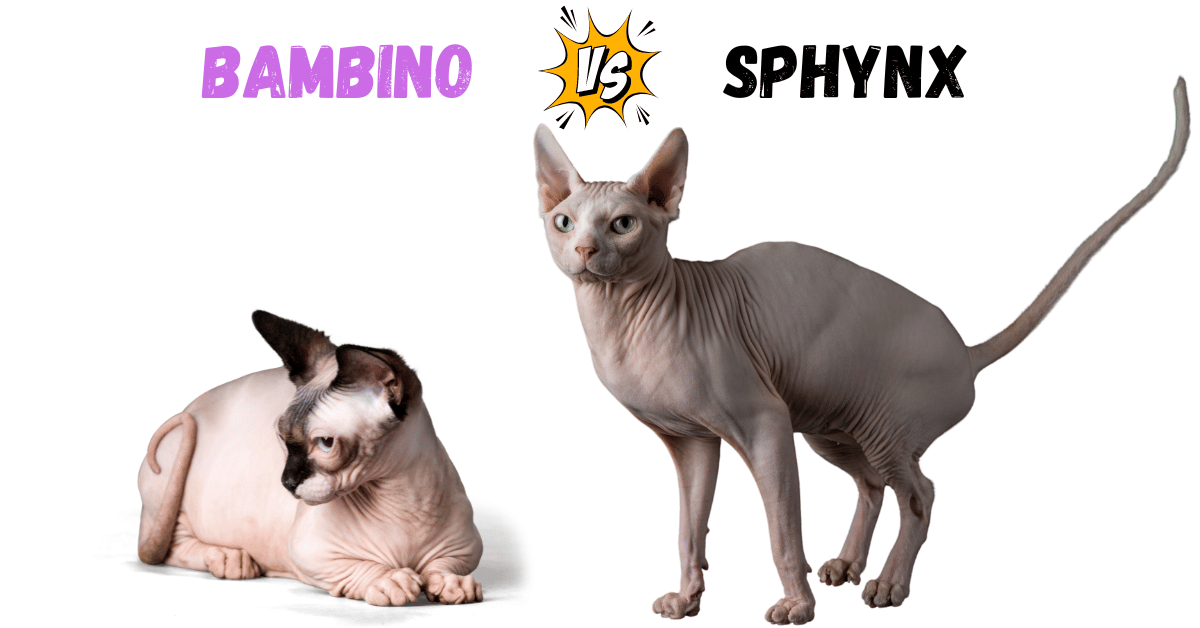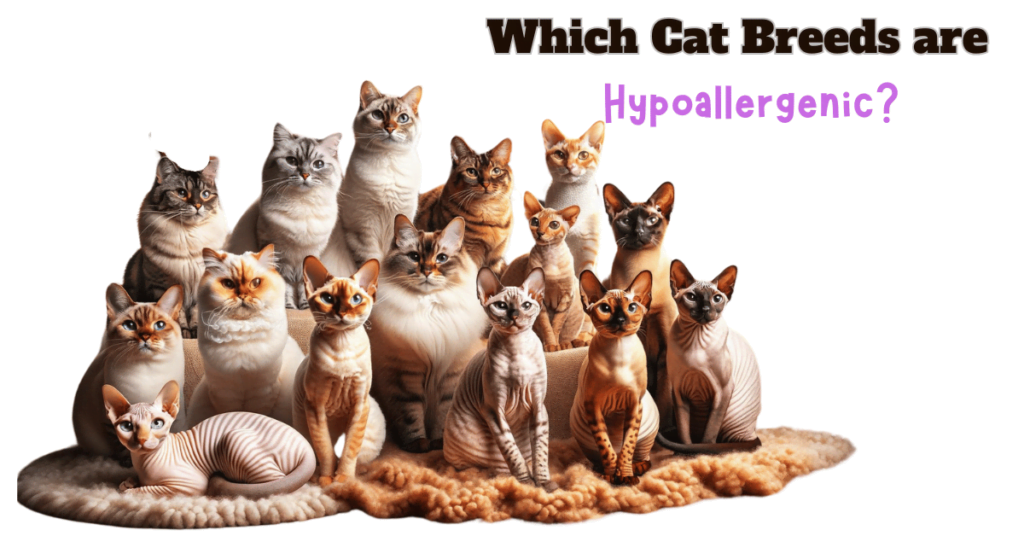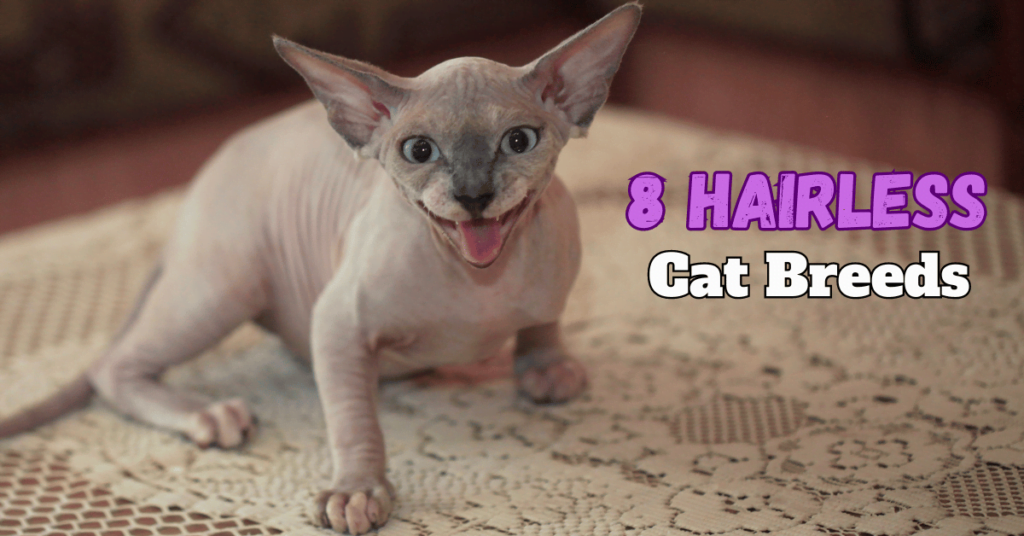This post contains affiliate links and I will be compensated if you make a purchase after clicking on my links.
Bambino Cat vs Sphynx: Unique Beginnings
The fascinating origins of two of the most distinctive breeds in the feline world, the Sphynx and the Bambino, reveal much about their unique characteristics.
Known for its striking, hairless appearance and dynamic personality, the Sphynx first appeared in the 1960s in Canada through a natural genetic mutation. Its skin, often compared to the feel of a warm peach, and wide, lemon-shaped eyes exude a sense of perpetual curiosity and wonder.
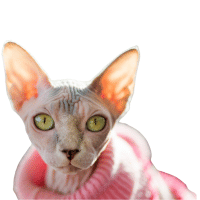
In contrast, the Bambino made a bold debut in 2005, merging the hairless allure of the Sphynx with the diminutive stature of the Munchkin cat.
This combination brings together two unique mutations, creating a compact, eternally kitten-like breed. Named ‘Bambino,’ Italian for ‘baby,’ this breed encapsulates the essence of its pint-sized and youthful charm but has also sparked controversy due to the deliberate breeding of dwarf traits.
Join us as we delve deeper into what it means to live with and love these extraordinary cats.
Comparative Aesthetics: Sphynx vs. Bambino
The Sphynx and Bambino cats both turn heads with their distinctive hairless appearances, yet they present unique features that set them apart.
The Sphynx cat is known for its elegant long lines and somewhat loose skin, which forms charming wrinkles. This breed can range from being completely bald to having a fine peach fuzz that gives their skin a suede-like texture.
Commonly, they might sport a bit of short hair on the nose and ears. Standing about 8 to 10 inches tall at the shoulder and weighing between 5.5 to 12 pounds, Sphynxes are medium-sized with a notably elongated appearance.
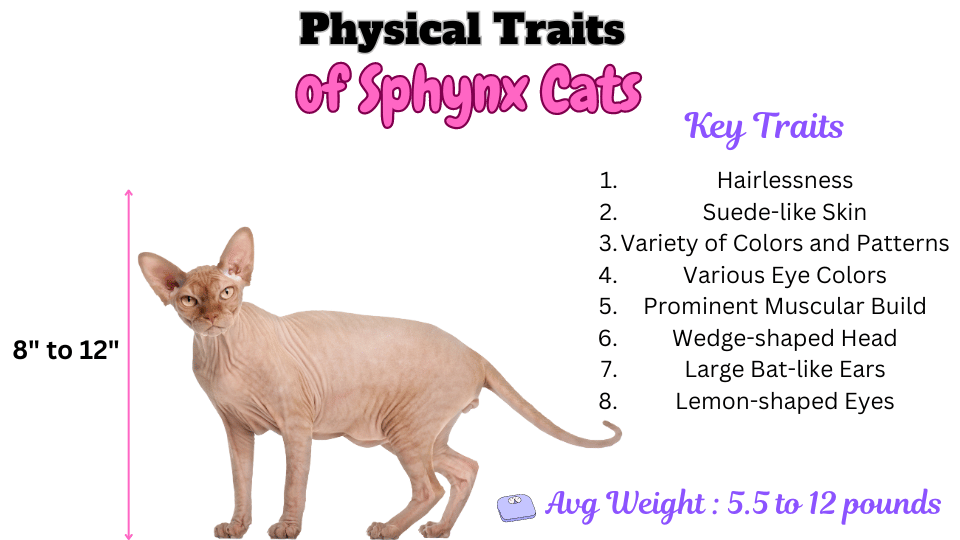
In contrast, the Bambino cat, smaller in stature, stands only about 7-9 inches tall and typically weighs between 5 and 9 pounds. Their hairlessness can also vary, from completely bare skin to a soft peach fuzz, and their skin often features deep wrinkles.
What truly distinguishes Bambinos is their short, stocky legs which contribute to a robust yet compact frame, impacting their ability to jump and move like their taller relatives.
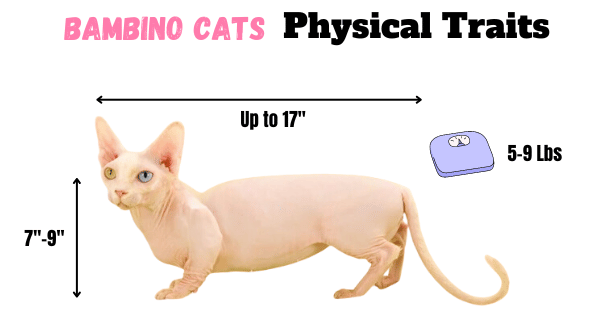
Color Palette and Eye Color
Both breeds showcase a dazzling array of colors and patterns, including white, black, red, brown, and lilac, available in designs ranging from solid to tabby or spotted. This diversity ensures each cat boasts a one-of-a-kind appearance.
Sphynx cats may display any feline eye color, contributing to their expressive and varied visages. In contrast, Bambino cats are often noted for their striking blue or lemon-shaped eyes, which underscore their curious and engaging expressions
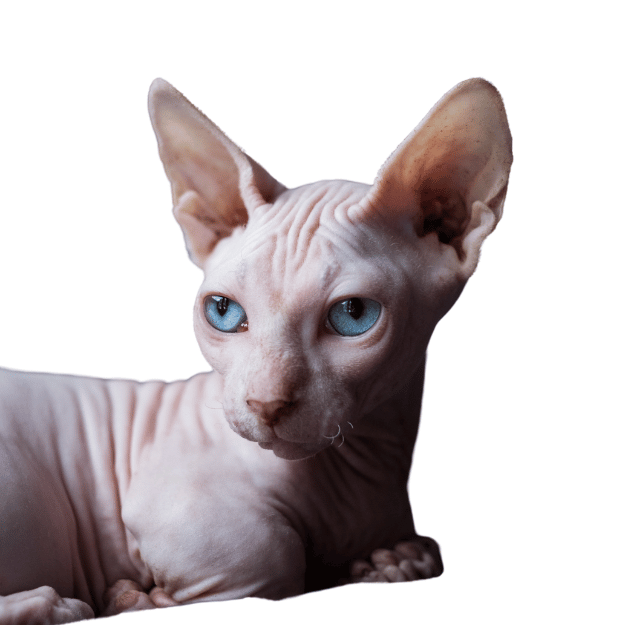
Personality and Temperament: Bambino Cat vs Sphynx
Unlike the stereotypical aloof cat, these breeds thrive on human interaction. They actively seek out laps, cozy up under blankets, and provide constant companionship, whether you’re working at your computer or relaxing with TV.
Bursting with energy and playfulness, both breeds often embark on household adventures like scaling bookshelves or playing hide-and-seek. Their antics are entertaining and a delightful distraction from daily routines. Owners often report dog-like loyalty and affection, with these cats following them from room to room and participating in household activities.
Recognized for their intelligence and sociability, Bambino and Sphynx cats quickly engage with interactive toys and puzzles, challenging their sharp minds. This intellect, combined with their social nature, makes them get along well with humans and other pets, making them perfect additions to lively homes.
Both breeds adore human attention, often expressing their happiness through vocal purrs and chatters, showcasing their joy in being part of a loving family.
Fact: Both the Bambino and Sphynx form strong bonds with their family members and can suffer from loneliness if left alone for extended periods
Health Considerations and Longevity
When considering the health and longevity of Bambino and Sphynx cats, it’s essential to understand their unique traits and potential health issues. Both breeds are generally healthy and can live long, happy lives, but they do have specific health considerations.
Lifespans
- Sphynx Cats: The life expectancy of a Sphynx cat is typically between 8 and 14 years.
- Bambino Cats: Bambino cats have a slightly longer lifespan, generally living between 10 and 14 years.
Health Issues
Sphynx Cats
Sphynx cats, with their lack of fur, are prone to skin conditions, such as fungal infections and sunburn. Regular bathing and skin care are essential to keep their skin healthy. Additionally, they can suffer from hypertrophic cardiomyopathy (HCM), a common heart condition in cats.
Bambino Cats
Bambino cats can inherit health issues from both the Sphynx and Munchkin breeds. They are susceptible to the same skin conditions and heart issues as the Sphynx. Moreover, due to their Munchkin heritage, they can face musculoskeletal issues. The short legs of Bambino cats can lead to spinal problems and joint disorders, which can affect their mobility and quality of life as they age.
As a fairly new breed, there is still much to discover about the long-term health and care needs of Bambino cats.
Pro Tip: Ensure your Bambino or Sphynx cat enjoys a long, healthy life by getting them from a reputable breeder, maintaining regular veterinary check-ups, and providing proper care. This includes a balanced diet, consistent grooming, and a stimulating environment.
Grooming and Care Essentials
Hairless cats require regular bathing to manage the natural oils their skin produces, as they lack fur to absorb these oils. For both Bambino and Sphynx cats, a weekly bath is recommended to prevent oil buildup and maintain skin cleanliness.
However, it’s essential to find a balance; over-bathing can dry out their skin and cause irritation, while insufficient bathing leads to oily residues on your furniture and a noticeable body odor.
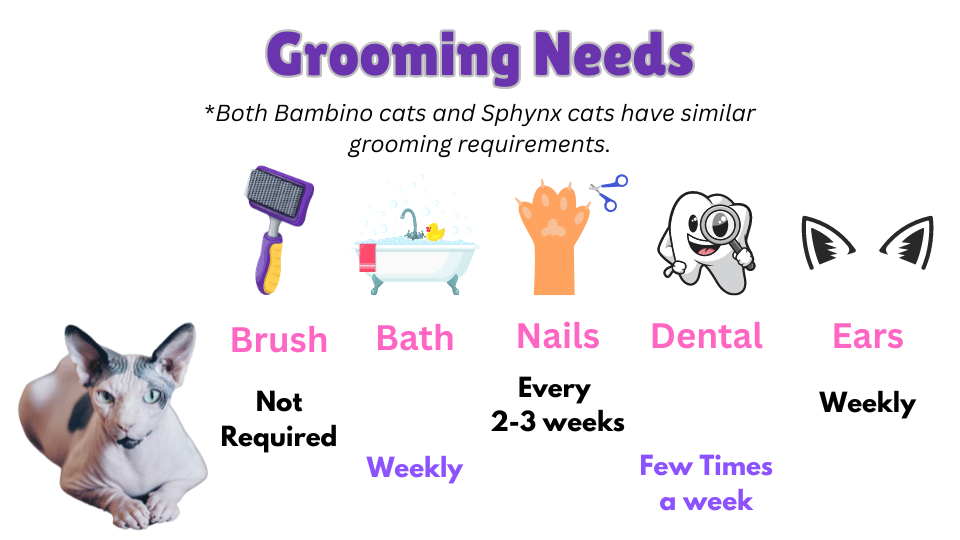
Tip: Not all Bambino or Sphynx cats enjoy baths, but many adapt to them as part of their early grooming routines. If baths are too stressful, using pet-safe wipes is a practical alternative to keep them clean.
Comprehensive Grooming: Beyond Just Bathing
The grooming needs of both these cats extend beyond regular bathing:
- Eyes and Ears: Weekly checks are necessary to clean any build-up, as their lack of hair does not protect these areas, making them prone to dirt accumulation. Using vet-approved ear cleaners and gentle wipes can help maintain these sensitive areas.
- Claws and Paws: Their paws and claws also require attention to remove any grime. A gentle soak during bath time can facilitate easier cleaning.
- Dental Care: Daily dental care is ideal for maintaining the oral health of these cats, with a minimum of a few times a week being essential.
- Brushing: Unlike their furry counterparts, Bambino and Sphynx cats do not require regular brushing of their hair, as they either have no hair or only a fine layer of down.
Fact: Due to their exposed skin, Bambino and Sphynx cats are susceptible to cuts, scrapes, and the effects of extreme temperatures. Protective clothing may be necessary, especially if they enjoy sunbathing.
Are Bambino and Sphynx Cats Hypoallergenic?
While Bambino and Sphynx cats aren’t officially classified as hypoallergenic, they come remarkably close for those usually troubled by pet allergies. Their hairless nature significantly reduces the amount of fur and, consequently, airborne dander in your home—dander being a primary allergen for many people.
Although Sphynx cats still produce the Fel D1 protein, which is found on their skin and in their saliva and can trigger allergies, the overall lower levels of allergens make them more tolerable for allergy sufferers.
Official Recognition of Bambino and Sphynx Cats
The Sphynx cat is recognized by major feline organizations like the Cat Fanciers’ Association (CFA) and The International Cat Association (TICA). Sphynx cats were accepted for registration by the CFA in 1998 and advanced to Championship status in 2002.
In contrast, the Bambino is not yet a recognized breed. The International Cat Association (TICA) acknowledged the Bambino as an “experimental” breed in 2005.
However, this distinction makes little difference if you are not interested in cat shows and competitions, as both breeds make wonderful pets regardless of their official status.
Conclusion: Bambino Cat vs Sphynx
Choosing between a Bambino and a Sphynx is more than just an aesthetic decision—it’s a commitment to embracing a pet with unique needs, vibrant personality, and immense affection. These hairless wonders require dedicated care, from their skin to their social lives, but the rewards are immeasurable.
Both Bambino and Sphynx cats thrive best with a companion. If possible, adopting one of each can be the best decision, as they go well together and keep each other company. Whether you’re captivated by the elfin charm of the Bambino or drawn to the elegant allure of the Sphynx, bringing both into your home can transform your life, filling it with joy, laughter, and lots of cuddles.
Are you ready to meet your new best friends? They’re waiting to steal not just your seat but also your heart. Discover everything you need to keep them comfortable and cared for on our Hairless Cat Products Page. From soothing skin care to cozy comforts, make sure your new pals feel right at home from day one.
Meet Sean, a fintech whiz with a penchant for pet purrs and blockchain buzz. After a decade of fintech feats, Sean’s tech talents leaped from ledger lines to litter lines, driven by a passion for pets and a vision for a more connected pet care community. With three critter companions as co-pilots, Sean launched this blog to share a treasury of pet-friendly tech tips and tales.

